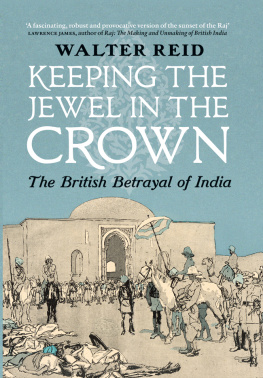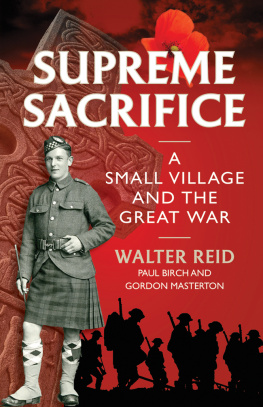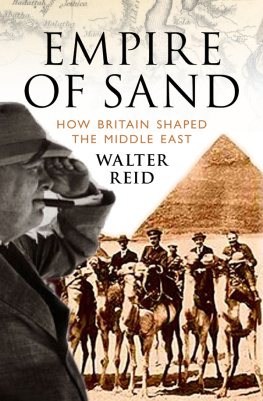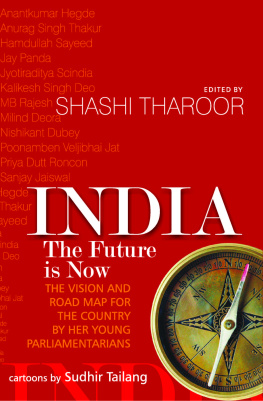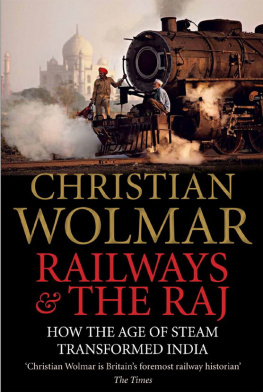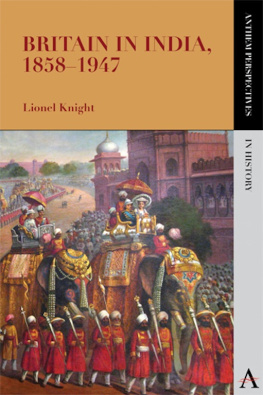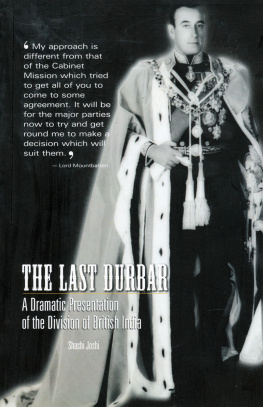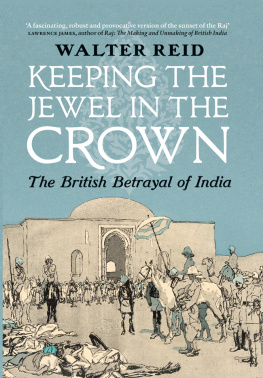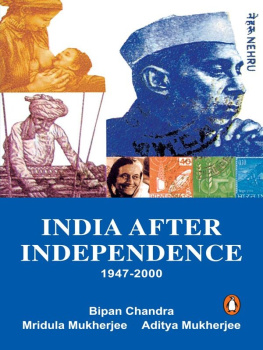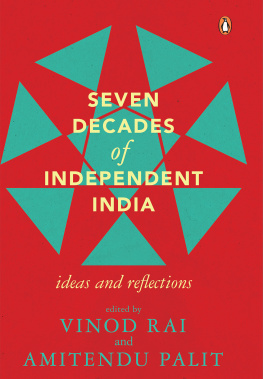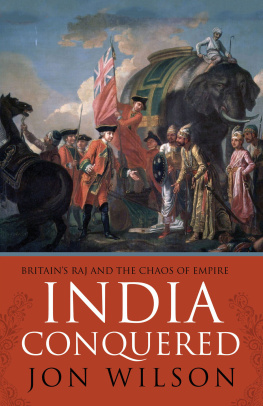KEEPING THE
JEWEL IN THE
CROWN
Other books by Walter Reid
A Volunteers Odyssey: Arras 1917
(second edition, Arras 1917: The Journey to Railway Triangle)
Architect of Victory, Douglas Haig
Churchill 19401945: Under Friendly Fire
Empire of Sand: How Britain Made the Middle East
This book is for Flora and Arthur
First published in 2016 by
Birlinn Limited
West Newington House
10 Newington Road
Edinburgh
EH9 1QS
www.birlinn.co.uk
Copyright Walter Reid 2016
The moral right of Walter Reid to be identified as the author of this work has been asserted by him in accordance with the Copyright, Designs and Patents Act 1988
All rights reserved.
No part of this publication may be reproduced, stored or transmitted in any form without the express written permission of the publisher.
ISBN 978 1 78027 336 5
eISBN 978 0 85790 900 8
British Library Cataloguing-in-Publication Data
A catalogue record for this book is available from the British Library
Facsimile origination by Hewer Text (UK) Ltd
Printed and bound by Gutenberg Press, Malta
CONTENTS
LIST OF ILLUSTRATIONS
ACKNOWLEDGEMENTS
The question which this book is intended to answer began to form in my mind during my first visit to India. It was, Did the British mean to leave all this?, and it was prompted by architecture.
The buildings in question were perhaps surprisingly not the magnificent, triumphalist monuments of Delhi. Lutyens concept of New Delhi was certainly an extravagant, public assertion of the grandeur and permanence of the imperial project, and interestingly it was a statement made later than might have been expected. New Delhi only became Indias capital in 1911, and the great Lutyens buildings were completed twenty years after that. The Viceroys House, for long the largest Head of States residence in the world, wasnt ready for occupation until 1929. All of this building for a continuing imperial future was therefore going on at the same time as the Montagu Declaration and the Irwin Declaration led Indians to think that there wasnt going to be an imperial future.
But Lutyens creations were inherently exotic, extraneous to India. What struck me more forcibly was the organic nature of Mumbais architecture and what it revealed. The British influences are obvious. The University looks familiar to a Scot, because the architect Sir George Gilbert Scott had a hand in it as well as in Glasgow University. The Law Courts look very like the Courts in the Strand. The Victoria Railway Station could be in any great British city. But this huge financial centre is not a political statement. The array of the commercial buildings of the city in all their wealth of western styles, including an enormous art deco element, represents a continuing capital investment and commitment that looks far into the future. Did the British honestly mean to leave all this?
I approached the question without prejudice. Indeed, as I started from the view, to which I adhere, that the Indian Civil Service, the men who administered India from India, as opposed to the Indian Office, chiefly in Britain, which ruled India in a more political sense, were highly-principled and motivated by a powerful sense of duty, I rather expected to end up accepting the traditional British view of an honourable commitment to leading the subcontinent to independence as early as possible. Alas, as I proceeded on my journey I came increasingly and inescapably to a much more sombre conclusion.
Sad though that is, the journey was fascinating. I wish to take the opportunity of thanking some of those who helped me along the way. Sir Dickie and Lady Stagg were generous hosts at the High Commissioners Residence in Delhi, where the journey began. I am particularly grateful to Arabella for sharing with me her enthusiasm for some contemporary Indian writers. Paul Addison of Edinburgh University and John Hussey, OBE, very kindly read this work in typescript, and I am hugely indebted to them for their comments and recommendations. I must also record my gratitude to Lawrence James and John Keay. Their own works on India are essential reading.
My thanks go to Dawn Broadley, whose input in terms of research and generally making the text fit for the publishers has been essential and has made the writing process much more fun than it otherwise would have been. Fun is the word Id associate too with my publishers, Birlinn. Hugh Andrew presides over a very large list without losing his enthusiasm for its components, and the Editorial Director, Andrew Simmons, copes with an immense work-load without ever making it seem like work. Helen Bleck was a very kind copy-editor, gently excising innumerable errors and solecisms without communicating any sense of exasperation.
Indian history was the research area of my younger daughter, Bryony, and I am grateful to her for reading the text at an early stage and for valuable comments in regard to structure and argument. As a journalist, my wife, Janet, also sharpened my dialectical edge as well as brushing away infelicities in the course of more proof-reading than anyone should be asked to undertake. Because it is so true, I have no embarrassment in summing up my gratitude to her by saying again what I have said before: life is great fun, but it wouldnt be without her.
Argyll
April 2016

British India and the Princely States

Distribution of Muslim population in 1909
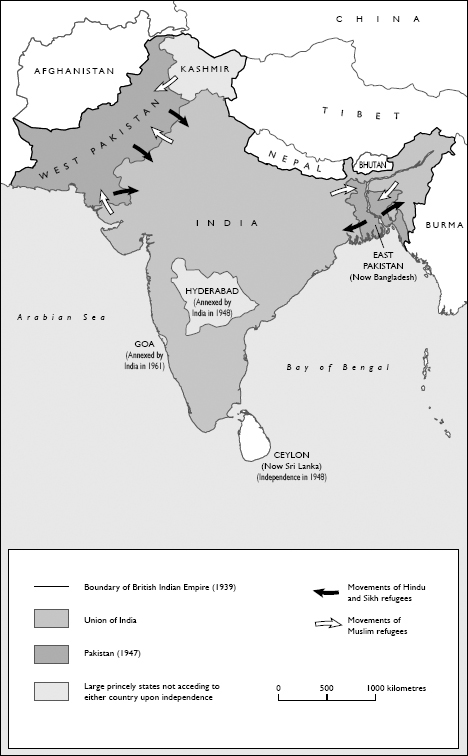
Partition
PRINCIPAL EVENTS
1917 | Montagu Declaration |
1919 | The Rowlatt Act Jallianwala Bagh (or Amritsar) massacre MontaguChelmsford reforms (The Government of India Act 1919) |
1920 | First civil disobedience campaign |
1925 | Satyagraha |
1926 | Balfour Report |
1928 | Simon Commission |
1929 | Irwin Declaration |
1930 | Salt Satyagraha |
193032 | Round-table conferences |
1931 | Statute of Westminster |
1935 | Government of India Act 1935 |
1942 | Cripps Mission Quit India movement |
1946 | Cabinet Mission |
1947 | Partition and Independence |
POLITICAL FRAMEWORK


INTRODUCTION

